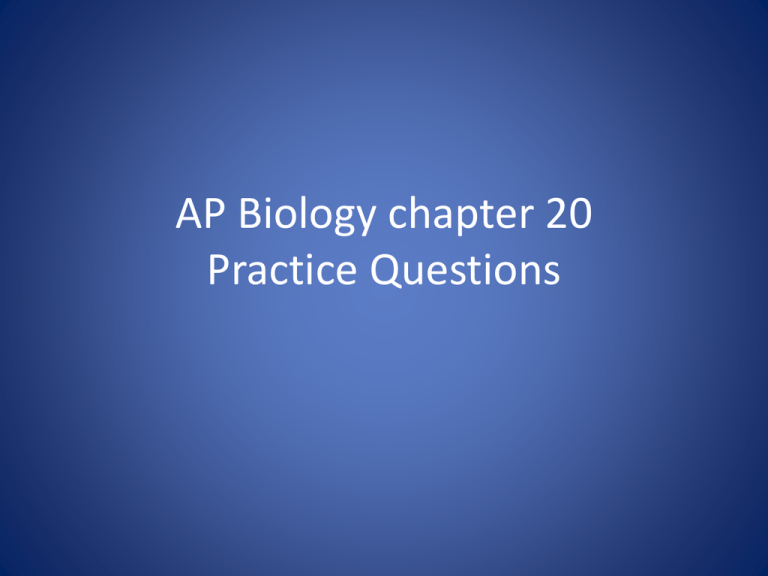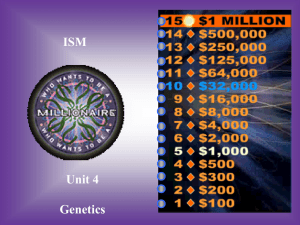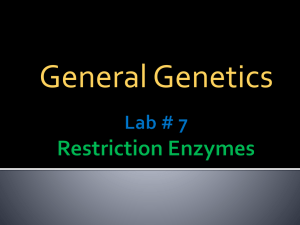
AP Biology chapter 20
Practice Questions
1) Plasmids are important in biotechnology
because they are
A) a vehicle for the insertion of recombinant
DNA into bacteria.
B) recognition sites on recombinant DNA
strands.
C) surfaces for protein synthesis in eukaryotic
recombinants.
D) surfaces for respiratory processes in
bacteria.
E) proviruses incorporated into the host DNA.
2) Which enzyme was used to produce the
molecule in Figure 20.1?
A) ligase
B) transcriptase
C) a restriction enzyme
D) RNA polymerase
E) DNA polymerase
3) What is the genetic function of restriction
enzyme?
A) adds new nucleotides to the growing
strand of DNA
B) joins nucleotides during replication
C) joins nucleotides during transcription
D) cleaves nucleic acids at specific sites
E) repairs breaks in sugar-phosphate
backbones
4) What is a cloning vector?
A) the enzyme that cuts DNA into restriction
fragments
B) a DNA probe used to locate a particular
gene in the genome
C) an agent, such as a plasmid, used to
transfer DNA from an in vitro solution into a
living cell
D) the laboratory apparatus used to clone
genes
I. Transform bacteria with recombinant DNA molecule
II. Cut the plasmid DNA using restriction enzymes
III. Extract plasmid DNA from bacterial cells
IV. Hydrogen-bond the plasmid DNA to nonplasmid DNA
fragments
V. Use ligase to seal plasmid DNA to nonplasmid DNA
5) From the list above, which of the following is
the most logical sequence of steps for splicing
foreign DNA into a plasmid and inserting the
plasmid into a bacterium?
A) I, II, IV, III, V
D) III, IV, V, I, II
B) II, III, V, IV, I
E) IV, V, I, II, III
C) III, II, IV, V, I
6) All of the following statements about probes
are true except:
A) They are single-stranded segments of DNA or
RNA.
B) Shorter probes adhere to more fragments
than do longer probes.
C) The probe must be labeled with a radioactive
isotope or fluorescent tab.
D) They must be produced with the same
restriction enzyme as the fragments.
E) In many cases, a probe from one organism
can be used to locate a homologous DNA
segment in another organism.
7) The principal problem with inserting an
unmodified mammalian gene into the bacterial
chromosome, and then getting that gene
expressed, is that
A) prokaryotes use a different genetic code from
that of eukaryotes.
B) bacteria translate polycistronic messages only.
C) bacteria cannot remove eukaryotic introns.
D) bacterial RNA polymerase cannot make RNA
complementary to mammalian DNA.
E) bacterial DNA is not found in a membraneenclosed nucleus and is therefore incompatible
with mammalian DNA.
8) Yeast cells are frequently used as hosts for
cloning because
A) they are easy to grow.
B) they have multiple restriction sites.
C) they have plasmids.
D) A and B are correct.
E) A and C are correct.
9) produces multiple identical copies of a
gene for basic research or for large-scale
production of a gene product
A.
B.
C.
D.
E.
restriction enzymes
gene cloning
DNA ligase
gel electrophoresis
reverse transcriptase
10) separates molecules by movement due
to size and electrical charge
A.
B.
C.
D.
E.
restriction enzymes
gene cloning
DNA ligase
gel electrophoresis
reverse transcriptase
11) Which enzyme permanently seals
together DNA fragments that have
complementary sticky ends?
A.
B.
C.
D.
E.
restriction enzyme
DNA ligase
reverse transcriptase
RNA polymerase
DNA polymerase
12) Which enzyme is used to make multiple
copies of genes in the polymerase chain
reaction (PCR)?
A.
B.
C.
D.
E.
restriction enzyme
DNA ligase
reverse transcriptase
RNA polymerase
DNA polymerase
13) Which enzyme cuts DNA molecules at
specific locations?
A.
B.
C.
D.
E.
restriction enzyme
DNA ligase
reverse transcriptase
RNA polymerase
DNA polymerase
14) The Southern blotting procedure enables
the detection and analysis of DNA sequences.
This means that
A) the existence of specific sequences can be
determined.
B) the number of sequences can be determined.
C) the size of restriction fragments that contain
the sequence can be determined.
D) the DNA of individuals and species can be
compared.
E) all of the above are possible using the
Southern blotting procedure.
15) Surprisingly, the human genome contains
fewer genes than expected. How, then, is the
human genome more complex than that of
other organisms?
A) RNA transcripts of human genes are more
likely to experience alternative splicing.
B) Post-translational processing adds diversity
to the resulting polypeptides.
C) Polypeptide domains are combined in a
variety of ways.
D) Different combinations of exons are used.
E) All of the above are correct.
16) Gene therapy
A) has proven to be beneficial to HIV patients.
B) involves replacement of a defective allele
in sex cells.
C) cannot be used to correct genetic
disorders.
D) has its greatest chance of success with
bone marrow cells.
E) is a widely accepted procedure.
17) Genetically engineered plants
A) are more difficult to engineer than
animals.
B) include a transgenic rice plant that could
help prevent vitamin A deficiency.
C) are being rapidly developed, but
traditional plant breeding programs are still
the method used to develop new plants.
D) are able to fix nitrogen themselves.
E) are all monocots.
18) Which of the following tools of
recombinant DNA technology is incorrectly
paired with its use?
A) restriction enzyme¹production of RFLPs
B) DNA ligase¹enzyme that cuts DNA, creating
the sticky ends of restriction fragments
C) DNA polymerase¹used in a polymerase
chain reaction to amplify sections of DNA
D) reverse transcriptase¹production of cDNA
from mRNA
E) electrophoresis¹DNA sequencing
19) Plants are more readily manipulated by
genetic engineering than are animals because
A) plant genes do not contain introns.
B) more vectors are available for transferring
recombinant DNA into plant cells.
C) a somatic plant cell can often give rise to a
complete plant.
D) genes can be inserted into plant cells by
microinjection.
E) plant cells have larger nuclei.
20) A paleontologist has recovered a bit of tissue
from the 400-year-old preserved skin of an extinct
dodo (a bird). The researcher would like to
compare DNA from the sample with DNA from
living birds. Which of the following would be most
useful for increasing the amount of dodo DNA
available for testing?
A) RFLP analysis
B) polymerase chain reaction (PCR)
C) electroporation
D) gel electrophoresis
E) Southern hybridization
21) Expression of a cloned eukaryotic gene in
a prokaryotic cell involves many difficulties.
The use of mRNA and reverse transcriptase is
part of a strategy to solve the problem of
A) post-transcriptional processing.
B) electroporation.
C) post-translational processing.
D) nucleic acid hybridization.
E) restriction fragment ligation.







